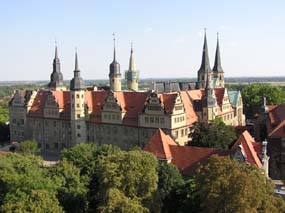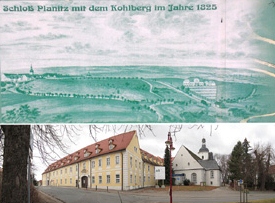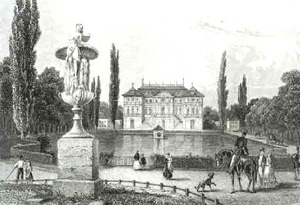Please click on an image below to enlarge it.
Schloss Merseburg with the Dom behind it.
saale-unstrut-tourismus.de
In 1831 Moritz started work here as an apprentice landscape gardener.
Schloss Planitz 1825 and 2011
wikicommons Markschneider dec 2011
From about 1841 until 1846/7 Moritz was the curator of the Schlossgarten at Planitz.
Grosser Garten Dresden - circa 1850
...
In 1847 Moritz was listed as Supervisor of the Royal gardens and Vintages, Dresden.
...
Friedrich Moritz, the second son of Painter Weidenbach, was born near Dresden in 1816. He moved to Naumburg an der Saale with his parents when he was one year old. In 1831, at the age of 15 years, he was apprenticed to Herr Steubecke (or Stäubke), curator of the gardens at the historic royal palace at Merseburg, on the river Saale, about 30 km north of Naumburg. In 1842, he married Herr Steubecke's daughter, Diosma Augusta.
Merseburg: Merseburg is an important part of the history of the Weidenbach family. Not only was it the place where Moritz learnt his profession but it was also the place of residence of the family of his influential wife Diosma and of her sister Erica, who married Moritz's younger brother Ernst.
The Merseburg Schloss was a favourite residence of German kings during the 10th, 11th and 12th centuries. From 1657 to 1738 it was the residence of the dukes of Saxe-Merseburg. In 1815, when Saxon-Anhalt was ceded to Prussia, the Schloss was occupied by the regional Prussian Governor and part was reserved for occasional visits by the Prussian Kaiser. In 1825 the renowned Prussian landscape architect, P.J. Lennie, redesigned the palace garden including the landscaped river bank. When Moritz arrived five years later he would have worked on the implementation of this plan. Moritz's predecessor as apprentice landscape gardener at Merseburg was Richard Schlomburgk ( http://adb.anu.edu.au/biography/schomburgk-moritz-richard-4543 ) who later became the highly distinguished curator of the Adelaide Botanic Gardens.
Planitz: In about 1841 Moritz
became the curator of the gardens at Planitz. From 1689
until 1923 this stately home belonged to the Von Arnim
family.
For an account of the colourful history of the property see
"Planitzer Geschichte" on the website:
http://www.planitz-sachsen.de/ . Underlying the von
Arnim land on Planitz hill there was a major coalfield which
had been mined for hard coal since the 18th Century. During
the 19th Century, mine shafts were scattered over the
remainder of the hill and in 1846, at about the time Moritz
would have left Planitz, a coking plant was built.The coking
coal brought great riches to the Saxon Von Arnims.
Today the Schlossgarten is the typical English landscape garden which was constructed for Isolde Von Armin in 1870. When Moritz was there it would have been a Baroque style Pleasure Garden and Plant Garden.
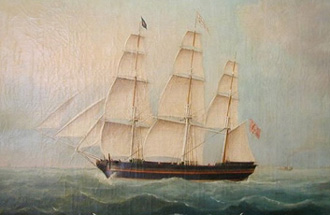
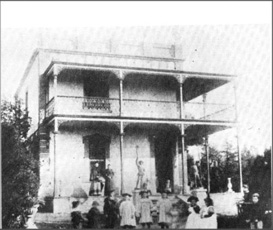
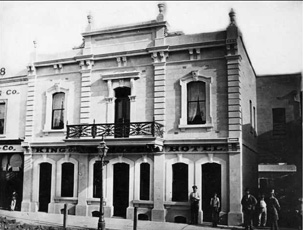
The Sailing Ship Pauline
http://people.freenet.de/danziger-seeschiff/ Hermann Behrent,Danzig
Moritz left Bremen on the sailing ship "Pauline" on 21/11/1847 and arrived in Adelaide, South Australia on 31/3/1848.
Glen Coola Homestead 1870
The Paddocks Beneath. History of Burnside. Eliz. Warburton 1981
In the mid-1850s Moritz and Max built "Glencoola" and "The Olives" in Portrush Road, Glen Osmond.
King of Hanover Hotel 1880
Hotels and Publicans in South Australia J.L. Hoad 1999
Moritz' wife Diosma and her son Edwin operated, among other businesses, the King of Hanover Hotel in Rundle Street
Moritz emigrated to South Australia with his family in late 1847. It appears that Moritz emigrated rather suddenly to escape the social and political unrest preceding the 1848 revolution. On the 21st of November, 1847, he left Bremen on the sailing ship PAULINE, arriving in Adelaide South Australia on the 31st March, 1848. He was accompanied by his three children: Benno (4 years), Anna (3 years), Max (12 months) and his pregnant wife, Diosma. On the 23rd January, at 23 degrees latitude off the coast of Brazil, Diosma gave birth to a daughter, Pauline Oceanea. He was also accompanied by one of his gardeners from Dresden, J.G. Hofmann, and possibly one or two other servants.
In 1852 Moritz went to the Victorian goldfields with his brother Maximilian. They are said to have prospered and they returned home to build two large houses in Glen Osmond, Adelaide: "Glencoola" for Max and "The Olives" for Moritz and Diosma. Moritz' son Edwin greatly extended Glencoola in the late 19th century. Glencoola later became part of PGC and is now Abergeldie Private Hospital.
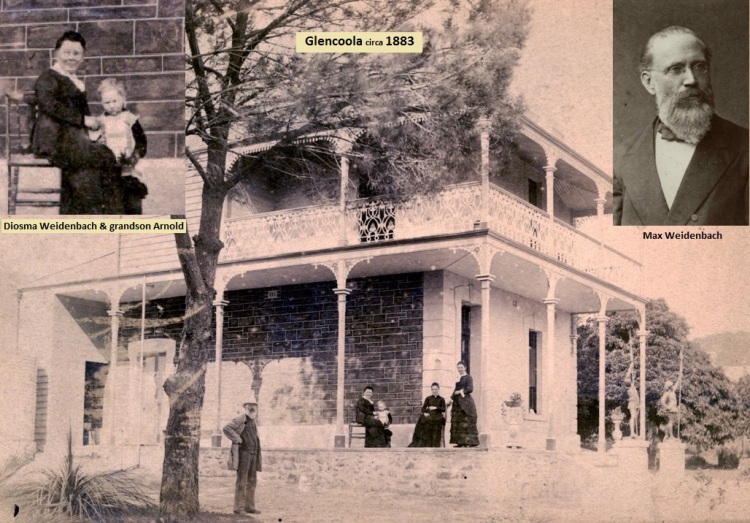
Moritz and Diosma Augusta had nine children:
Benno Weidenbach (1844-1917); Anna Bartels
(1846-1910); Maximilian Weidenbach (1847-1886);
Pauline Oceana Pustkuchen (1848-1929);
Edwin Weidenbach (1852-1927); Selma Clausen (
1853-1931); Diosma Laura Weidenbach (1854-1857);
Clara Weidenbach ( ??? ); Julius Weidenbach
(185?-1948?).
Until his death in January 1858 Moritz worked as a nurseryman, orchardist and pioneer winegrower. After his death Diosma was the matriach of this large, active and diverse family, the majority of whom went on to successful careers in trade, business and agriculture. Under the direction of Diosma (assisted by Moritz' brother, Max) Moritz' estate prospered. It included various properties and a central Adelaide hotel, the King of Hanover in Rundle Street.
Diosma died on the 17th December 1900, aged 83 years.

This information has been compiled from the documents and references which can be seen by following this link.


